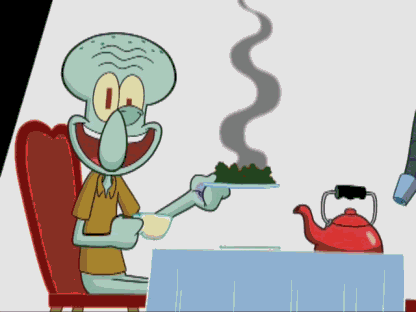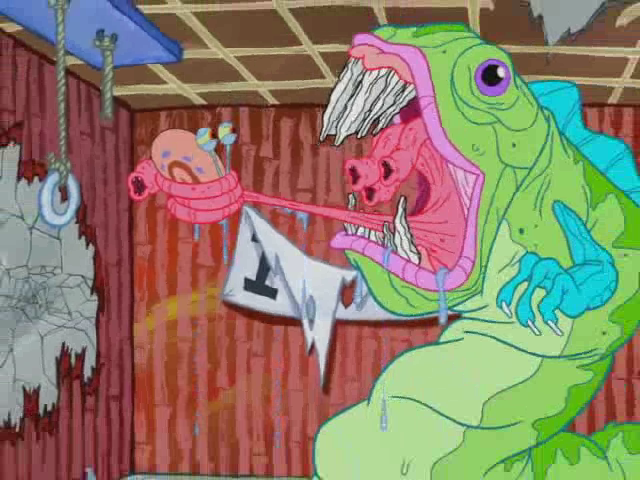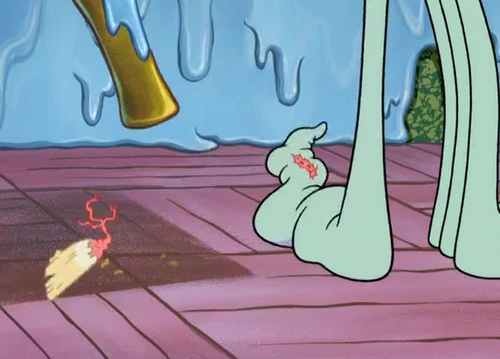Top 10 Worst SpongeBob SquarePants Episodes
Jared Korotney
October 19, 2015
On May 1, 1999, the first SpongeBob SquarePants episode, "Help Wanted", aired on televisions around the United States. From then until the 4th season, the show looked to be one of the greatest cartoon series of the 21st century. That all changed by the time SpongeBob SquarePants: The Movie aired in theaters in 2004, when fans complained about the quality of episodes airing after the movie's premiere, mostly due to a new board of writers for the series after the primary writers and director stepped down from the positions. Today, I have compiled a list of ten episodes that I consider to be the worst in the series, all of which aired after the release of the movie. Keep in mind, before I start off this list, that these are personal opinions, not just what the public directly wants to hear.
First, some honorable, or in this case, dishonorable mentions:
SpongeBob, You're Fired!
The most recent episode to be seen on this countdown, I couldn't quite make it on to my official top list. This so called "special" will probably be considered one of the worst excuses for a SpongeBob special ever. However, the reason it didn't get on the top 10 wasn't because of the content it possessed, but rather its weakness. The writers made an extremely lazy effort to put together a special, just for the sake of keeping their ratings up. Another reason for its low position is because of the actually interesting controversy it caused. Politicians wondered what message this episode was trying to send with its view on unemployment. That alone made this episode a standout in the sense that it was bad, but caused something to overshadow its awfulness.
Stuck in the Wringer
This episode didn't make the list due to the fact that I have been waiting for SpongeBob to get payback for all the trouble he's caused to the characters throughout the new seasons. Despite this, it was still highly mean-spirited and unfunny. Not to forget that this episode had, in my opinion, the second-worst ending to any episode in the series. The episode with the worst ending is one you will see on this countdown.
Pineapple Fever
This episode is a prime example of SpongeBob and Patrick's sheer stupidity. Much of this episode morphs from SpongeBob and Patrick turning their task of boarding up their house from a storm to making their version of what people are calling "Squidward torture porn". The humor is terrible, and it drags on for way too long. I was debating between this episode or the episode that took the number 10 slot. Ultimately, the other episode won, and you will see why, soon.
Now that I got my dishonorable mentions out of the way, here's what you've all been waiting for, so let's get started:
#10: Dear Vikings
 This is the episode with, in my opinion, the worst ending to any SpongeBob episode, ever. You take Pineapple Fever's unfunny jokes that drag on for way too long, and then you have it mate with Stuck in the Wringer's bogus ending, and you get the elicit love child that is Dear Vikings. Here's the basic premise of the episode.
This is the episode with, in my opinion, the worst ending to any SpongeBob episode, ever. You take Pineapple Fever's unfunny jokes that drag on for way too long, and then you have it mate with Stuck in the Wringer's bogus ending, and you get the elicit love child that is Dear Vikings. Here's the basic premise of the episode.
SpongeBob wants to know about vikings, so Squidward makes up ridiculous information about vikings to keep SpongeBob out of his hair (wait, Squidward doesn't have hair; never mind). Then, SpongeBob ends up sending a letter to the vikings to see what their lifestyles are like. What follows is a combination of forced humor, lazy writing, and for the most part of the second half of the episode, a lack of a plot, which all leads up to a 1 minute conflict at the very end. To quote MoBrosStudios,
"Dear new writers of SpongeBob, either learn how to write, or don't write at all!"
#9: Atlantis SquarePantis
Now, people that look frequently at lists of Top 10 Worst SpongeBob episodes would know that this special is frequent to the top of most of these lists, so I know that a lot of people may be surprised by its low position, but that is mainly because I have a soft spot in my heart for musicals, which this episode is. However, that doesn't excuse the fact that much of the music was unnecessary and forced. Most of the comedy you will see out of this episode comes with Patchy the Pirate's antics outside of the episode.
The idea for an episode where SpongeBob and his friends travel to Atlantis was actually a pretty interesting concept. It's just a shame that the execution of the special came off as not much more than a ratings trap. This special was terrible, but there is still one special that I feel triumphs as the worst special in SpongeBob history, which we'll get to in a little bit.
#8: Shuffleboarding
 I'm not entirely sure if there has ever been another episode of any other kid's cartoon show where the plot was scrapped halfway through the episode.
I'm not entirely sure if there has ever been another episode of any other kid's cartoon show where the plot was scrapped halfway through the episode.
Basically, SpongeBob and Patrick have to take over for Mermaid Man and Barnacle Boy in a shuffleboarding tournament, but for some reason, win the tournament before even arriving. What?! What kind of cheap writing is this? What's even worse is the new plot the new writers come up with, where SpongeBob and Patrick lock up every single person in Bikini Bottom for ridiculous crap. Seriously, nobody under the age of 5 would find this entertaining.
Whoever was in charge of directing and/or writing this episode deserves to get fired immediately. This episode is a prime reason why I feel bad for today's generation of kids. They only have this kind of crap to watch, and they will not learn anything from it, except for the crap that children's TV shows have become, today.
#7: The Splinter
Can I move on from this one? Please? No? Okay, fine. Let's get this one over with.
If there was a definition of "kid-friendly" gore, this episode would be it. SpongeBob basically gets a splinter stuck in his thumb and can't get it out. Things get worse when Patrick bashes the splinter further into his thumb, causing it to swell up to the size of a football. Once Mr. Krabs pulls the splinter out, we get a lovely image of green mucus spewing out of his thumb like a garden hose.
When a TV episode makes an adult like me to want to turn away, wash my eyes out with soap, and cry myself to sleep, you know it's too much for a kids show.
#6: Squid's Visit
 |
| Squidward going crazy after his house burns down. |
Remember when I said that The Splinter was the definition of "kid-friendly" gore? Well, Squid's Visit is the definition of "kid-friendly" psychological horror. For me, The Splinter was equivalent to The Human Centipede, while Squid's Visit was equivalent to The Omen. It is that much creepier and that much more psychotic.
SpongeBob steals Squidward's vacuum cleaner and forces him to come to SpongeBob's house for a "visit". What Squidward didn't know is that SpongeBob remodeled his house to look entirely like Squidward's, and is so detailed that SpongeBob even remembered a crack in the wall from when Squidward first moved in. And then Squidward's house burns down so he has to stay in SpongeBob's house.
This is insane. This is truly something that came straight out of a horror film. I'm not entirely sure if the writers were high when they made this episode, but it sure as heck feels like it.
#5: House Fancy
I'll just let this picture below do all of the talking.
#4: Truth of Square
The other special on this list, this one is what I truly believe to be the worst SpongeBob special ever. It was supposed to be a 10th anniversary special, but unfortunately, this episode stands now as having the worst case of Filler's syndrome I've ever seen on this show, with 28 minutes of this 50-minute special being filled with extraneous and unnecessary amounts of stars and cartoons you might see in a behind-the-scenes reel of a DVD. Also, way too many gimmicks were thrown in to make the episode, well, special. The Krusty Krab is celebrating its eleventy seventh anniversary (not even going to point it out). The crew gets locked into the ventilation system, where they decide to recall past memories of the Krusty Krab, and subsequently, all the customers leave.
I have never seen a special this poorly written and overhyped than this one, which makes this episode my worst SpongeBob special of all time.
#3: Boating Buddies
Brought to you by the same person who wrote and directed "Band Geeks", one of the most acclaimed episodes in the series. He must have gotten a demotion because of the crap of an episode he produced with Boating Buddies. This is an episode where SpongeBob is made to look like an antagonist with his absolutely stalker-like and, frankly, homosexual behavior towards Squidward.
Basically, the plot revolves around Squidward being sentenced to a day in hell with SpongeBob at boating school. Squidward is supposed to take an exam at the end of the episode, when SpongeBob gets him in trouble and lands him in a full body cast. And, surprise, Squidward fails the test because of it.
Honestly, if someone asked me to either ride on the Titanic or watch this episode again, I would choose the Titanic. I also forgot to mention this rape face:
#2: A Pal for Gary
 |
| Gary and SpongeBob's new pet, "Puffy Fluffy". |
Before I talk about this episode, let me just say that numbers one and two might as well be interchangeable. They are both that bad, and both are best friends with the worst episodes list.
Anyways, to describe how bad this is, this episode was the first ever episode that I made a rant about. There are absolutely no redeeming qualities of this episode. Mainly because of one scene where SpongeBob gets a new pet, names it "Puffy Fluffy", and it grows into a hideous monster. Gary fights it off, but is lifted into the air by the monster and is about to be eaten. Then, SpongeBob walks in and blames Gary for hurting the pet! I have never wanted to throw my TV out of a window before, but this made me cringe. This episode was the episode that made me lose all hope in SpongeBob IgnorantPants.
You know, this episode was flat out terrible, but there is still one episode that has content that should never be shown in any kids show.
#1: One Course Meal
 You know that you've screwed up your show when you incorporate characters attempting suicide, and you expect your viewers to find it funny. Really, Nickelodeon? You allowed this?
You know that you've screwed up your show when you incorporate characters attempting suicide, and you expect your viewers to find it funny. Really, Nickelodeon? You allowed this?
Well, that's exactly what happened in this episode. Mr. Krabs realizes Plankton has a fear of whales, so he puts on a whale costume and scares Plankton into submission. That's when Plankton lies in the middle of the street and waits for a car to run over him. Mr. Krabs is a protagonist, right? Shouldn't he get repercussions for doing things wrong? Nope, not in this case. In fact, in recent years, Mr. Krabs has been labeled more as a villain than a hero due to his greed. Also, SpongeBob's obliviousness to Plankton's suicide attempt was used for attempted comedic affect, which had very little success.
For me, these things make "One Course Meal" the worst episode in SpongeBob history.
 The concept of generalized linear models (GLM's) was formulated by John Nelder and Robert Wedderburn, and was originally used bring various types of models together, such as logistic regression models and Poisson regression models. As a form of regression analysis, generalized linear models are quite useful for evaluating dependent variables, each of which is assumed to have been created from a certain type of distribution. In these models, the mean of each distribution is dependent on the independent variables.
The concept of generalized linear models (GLM's) was formulated by John Nelder and Robert Wedderburn, and was originally used bring various types of models together, such as logistic regression models and Poisson regression models. As a form of regression analysis, generalized linear models are quite useful for evaluating dependent variables, each of which is assumed to have been created from a certain type of distribution. In these models, the mean of each distribution is dependent on the independent variables. 















_display.JPG)






